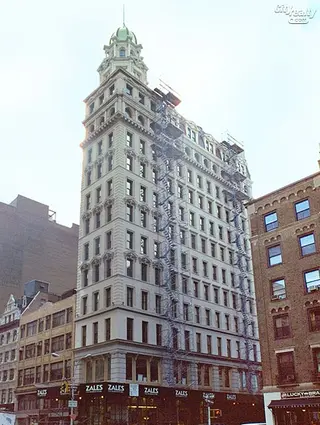 Carter Horsley
Carter HorsleyDec 15, 2014
Carter's Review
One of the city’s greatest mid-rise buildings, 170 Fifth Avenue was designed by Robert Maynicke in 1897 for Henry Korn and is known as the Sohmer Piano Building, after an early commercial tenant that invented the modern baby grand piano and later moved to 27 West 57th Street whose top was festooned with some of its awards and gilded statures before it was demolished by Vornado Realty in 2014.
This 13-story Beaux-Arts building, which is located in the Ladies Mile Historic District, was converted to 11 residential condominiums in 1999.
Bottom Line
With its gloriously shiny gold dome atop an octagonal base, this very handsome and elegant building has a narrow frontage on the southwest corner of Fifth Avenue at 22nd Street kitty-corner to the Flatiron building but a big presence in the Lower Fifth Avenue/Flatiron/Chelsea neighborhoods.
Description
According to dwellingsnyc.com, “some 2,700 sheets of 23.5-caret gold, each the size of an index card, were applied by hand” to the very prominent dome.
The historic district’s designation report contains the following commentary about the building:
“The two-story base of this building is flanked by double-height rusticated pilasters on marble bases supporting a dentiled stone cornice. Above the recently altered storefront the second story contains three single-pane wood sash windows separated by stone mullions capped with brackets. The transitional third story is faced in stone with three unadorned window openings containing one-over-one wood sash. This story is surmounted by a projecting geometric frieze. Stories four through ten are faced in brick, rusticated at the corners, with stone belt courses acting as sills for stories five, seven and nine. Each story contains three window openings with one-over-one wood sash; stories five, seven, and nine contain elaborate stone triangular pediments resting on consoles above the windows, while stories four, six, and eight have surrounds of stone with bead molding. A modillioned stone cornice above the tenth story completes this section of the building. The eleventh story is faced in stone with three arched window openings containing one-over-one sash flanked by pilasters and engaged Ionic columns that support a projecting stone cornice surmounted by engaged urns. The twelvth story contains three window surrounds with bezant ornament; these are crowned by a semicircular pediment in the center and flanking triangulated pediments. This section is also crowned by a projecting stone cornice. The Fifth Avenue façade is surmounted by a Renaissance-inspired octagonal dome resting on two one-story octagonal drums… The corners are marked by free-standing Corinthian columns supporting projecting portions of the entablature.”
The report also notes that the building’s western façade on 22nd Street on the 12th story is “crowned by a shingled mansard roof with dormer windows containing one-over-one sash flanked by stone pilasters supporting pediments containing projecting anthemion ornament.”
There are two other buildings in the neighborhood with prominent domes: 141 Fifth Avenue just north of 20th Street and the O’Neill Building at 655 Avenue of the Americas.
Amenities
The building has a part-time concierge.
Apartments
The building’s 10 full-floor apartments have 12-foot-high ceilings and about 2,736 square feet.
They have 43-foot-long living rooms with enclosed and windowed 17-foot-long kitchens.
The penthouse duplex has 5,281 square feet with a circular “baronial” staircase and bought in 2001 for $7.1 million by Gregory C. Carr, a former chairman of Prodigy, and was put on the market in 2005 for almost $18 million.
History
The building replaced a four-story structure and its early tenants included Cram, Goodhue & Ferguson, Robert Kohn, the architect of the nearby Spero Building on the same block, Goupil of Paris, art publishers, and Kraus & Deitsch, makers of fancy leather goods.
The site formerly housed the fourth location of the M. Knoedler & Co., the famous art gallery that went out of business in 2013 at its location on 70th Street between Fifth and Madison avenues.
The offices of the American Civil Liberties Union were in the building until 1960, according to daytonianinmanhattan.com.

- Condo built in 1898
- Converted in 1999
- 1 apartment currently for sale ($17.975M)
- Located in Flatiron/Union Square
- 11 total apartments 11 total apartments
- 8 recent sales ($2.4M to $4.5M)
- Doorman
- Pets Allowed
 6sqft delivers the latest on real estate, architecture, and design, straight from New York City.
6sqft delivers the latest on real estate, architecture, and design, straight from New York City.
